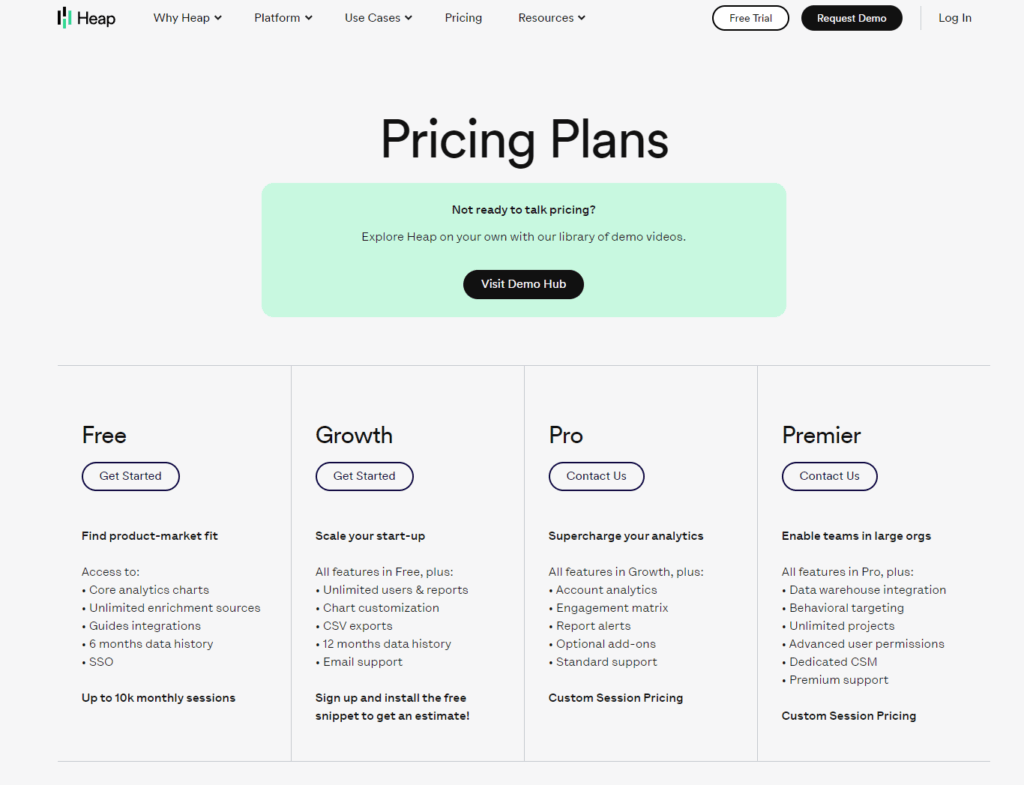In today’s data-driven business environment, choosing the right analytics platform can be as crucial as the strategic decisions that data informs. Enter Domo and Heap, two giants in the realm of analytics, each with its unique strengths and approach to deciphering the vast digital landscape’s data. But which one is the beacon for your business’s needs? Is it Domo, with its expansive enterprise capabilities and custom integrations, or Heap, renowned for its automatic data capture and user-centric insights? Let’s dive into this comparison
| Domo | Heap |
|---|---|
 |  |
| G2 Score – 4.4 out of 5 stars | G2 Score – 4.4 out of 5 stars |
| TrustRadius Score – 8.5/10 | TrustRadius Score – 8.2/10 |
Data Collection and Processing Capabilities
The Foundation of Insights
At the heart of any analytics tool is its ability to collect and process data. The efficiency, depth, and flexibility of this process can significantly impact the quality of insights you can extract. Here’s how Domo and Heap stack up in this fundamental area.
Domo: Customizable Data at Scale
Domo is designed to cater to large enterprises with complex data landscapes. It stands out for its robust data collection capabilities, enabling businesses to aggregate data from hundreds of sources, including cloud-based services, on-premise databases, and even spreadsheets. This wide net ensures that every piece of data, no matter where it resides, can be pulled into Domo’s ecosystem for analysis.
What sets Domo apart is not just the breadth of its data collection but also the depth of its processing capabilities. Domo provides powerful tools for transforming and cleaning data, ensuring it’s analysis-ready. Customizable ETL (Extract, Transform, Load) processes mean that businesses can tailor their data preparation to meet specific analytical needs, supporting sophisticated, data-driven decisions across the organization.
Heap: Automatic and Comprehensive Data Capture
Heap takes a different approach, focusing on automatic data collection, particularly around user interactions on websites and mobile apps. Without requiring manual setup for tracking events, Heap captures every click, form submission, page view, and more, right out of the box. This comprehensive, no-code approach to data collection ensures that no critical user action is missed, providing a complete picture of user behavior.
The strength of Heap lies in its ability to process this automatically captured data into actionable insights. By organizing interactions into meaningful events and segments after the fact, Heap allows businesses to analyze user behavior without having pre-defined what to track. This flexibility is invaluable for businesses looking to understand their user journeys in-depth, enabling rapid iteration and optimization of user experiences based on real-time data.
User Experience and Ease of Use
Empowering Users with Intuitive Analytics
In the complex world of data analytics, the simplicity and intuitiveness of a platform’s user interface can significantly affect how users interact with the tool and the insights they can glean. A platform that balances powerful analytics capabilities with a user-friendly interface enables businesses to democratize data across teams, making data-driven decision-making a part of the organizational culture.
Domo: Bridging Complexity with User-Centric Design
Domo stands out for its commitment to delivering a user-friendly experience without compromising on the depth and breadth of its analytics capabilities. It offers a visually appealing and intuitive interface, where users can easily navigate through different datasets, dashboards, and reports. The platform emphasizes customization and personalization, allowing users to tailor their analytics space to fit their specific needs and preferences.
One of Domo’s key strengths is its dashboard creation tool, which features a drag-and-drop interface, making it easy for users of all skill levels to create complex, interactive dashboards. This empowers users to visualize data in ways that are most meaningful to them, enhancing the understanding and accessibility of insights across the organization.
Heap: Simplifying Analytics with Automation
Heap takes a unique approach to user experience by automating many of the tasks traditionally associated with data analytics. Its automatic data collection mechanism ensures that all user interactions are captured without requiring manual setup, significantly reducing the initial learning curve and ongoing maintenance effort. This feature is particularly beneficial for product managers and UX designers who need to focus on deriving insights rather than managing data tracking.
Furthermore, Heap’s interface is designed to be straightforward and accessible, making it easy for users to navigate through different analytics features, such as funnel analysis, event visualization, and user segmentation. The platform’s focus on automating complex processes allows users to spend more time on analysis and less on configuration, streamlining the journey from data to insights.
Integration Capabilities
The Key to a Unified Data Ecosystem
The ability of an analytics tool to integrate with a wide array of data sources directly impacts the richness of insights it can deliver. Effective integrations not only streamline data workflows but also ensure that businesses can leverage their full suite of tools and platforms without data silos, enabling more informed decision-making.
Domo: Extensive Integration Network
Domo is renowned for its extensive integration capabilities, designed to cater to the complex data ecosystems of large enterprises. It boasts over a thousand connectors, encompassing a wide range of data sources from cloud-based services to on-premises databases. This vast network allows organizations to aggregate data from across their operations into a single analytics platform.
Beyond sheer quantity, Domo emphasizes the quality and depth of its integrations. It offers robust ETL (Extract, Transform, Load) features and data transformation tools, enabling users to refine and customize their data inputs for more precise analysis. This level of integration sophistication supports Domo’s aim to serve as a comprehensive, all-in-one analytics solution for businesses with diverse and expansive data needs.
Heap: Focused Integration for Web and Product Analytics
Heap, while operating on a different scale than Domo, offers focused integration capabilities particularly tailored for digital product analytics. It specializes in capturing user interactions directly from websites and mobile apps, providing a seamless way to collect and analyze product usage data. Heap integrates with a variety of platforms, including marketing automation tools, A/B testing services, and CRM systems, ensuring that user behavior data can be enriched and contextualized with information from across the marketing and sales funnel.
What sets Heap apart is its approach to integration that emphasizes ease of use and automation. By automatically tracking all user actions without the need for manual event setup, Heap simplifies the process of integrating analytics into product development and optimization workflows. This automated data collection feature is a significant boon for product teams looking to rapidly iterate on user feedback without getting bogged down in complex integration setups.

Related: Check out our free SEO suite

Scalability and Performance
Ensuring Analytics Evolve with Your Business
In a world awash with data, the capacity of an analytics platform to scale and perform under varying loads is not just a technical requirement but a business necessity. As organizations expand, so does the volume and complexity of their data. The chosen analytics platform must not only keep up with this growth but also continue to provide insights with minimal latency to support decision-making processes that are increasingly data-driven.
Domo: Engineered for Robust Scalability and Enterprise Performance
Domo is built with the needs of large enterprises in mind, offering a solution that excels in scalability and performance. Its cloud-based architecture is specifically designed to manage vast datasets and complex analytics operations across an organization. Domo’s platform can seamlessly scale to accommodate growth in data volume and user base, ensuring that businesses can rely on it for insights, regardless of their size or the complexity of their data environment.
The performance of Domo’s platform is optimized for speed, enabling quick data processing and real-time analytics. This is crucial for enterprises where timely access to insights can significantly impact strategic decisions and operational efficiencies. Domo’s commitment to performance extends to its data processing capabilities, ensuring that users can access and analyze their data swiftly, even as the demands on the system increase.
Heap: Agile Performance for Digital Products and Marketing Analytics
Heap offers a perspective on scalability and performance that’s tailored to the needs of digital businesses and marketing teams. Specializing in capturing and analyzing user interactions, Heap’s platform is designed to scale with the growth of web and mobile user bases, ensuring that businesses can continue to glean insights from their data without performance degradation.
Heap’s performance is geared towards providing real-time analytics, enabling teams to quickly iterate on digital products and marketing strategies based on up-to-the-minute data. This focus on agility makes Heap an attractive option for startups and fast-growing companies looking to maintain a competitive edge through continuous optimization and user-centric product development.
Customer Support and Community Engagement
Enhancing User Experience and Adoption
In the digital age, the relationship between a platform and its users extends far beyond the initial purchase. Ongoing support and a dynamic community are indispensable resources for users at all levels, offering guidance, inspiration, and a pathway to mastering complex analytics tools.
Domo: A Comprehensive Approach to Support and Community
Domo’s approach to customer support is multifaceted, designed to address the diverse needs of its extensive user base. The platform provides a rich array of support options, including dedicated account managers for enterprise clients, a responsive online help center, and direct channels for technical assistance. This ensures that users can find the help they need when they need it, whether they’re facing a complex integration challenge or simply seeking advice on best practices.
Equally important to Domo’s support infrastructure is its vibrant user community. Domo has successfully cultivated a thriving ecosystem where users from various industries and roles come together to share insights, tips, and success stories. This community is not just a forum for troubleshooting; it’s a hub of innovation where users can discover new ways to leverage Domo’s capabilities to drive their business forward. The company actively supports this community through regular events, user groups, and an annual conference, further enriching the Domo experience.
Heap: Tailored Support for Digital Analytics Mastery
Heap’s approach to customer support reflects its focus on delivering a streamlined, user-friendly analytics experience. With a keen emphasis on empowering digital product teams, Heap provides targeted support that addresses the unique challenges of web and mobile analytics. Users have access to a dedicated support team through email and in-app messaging, ensuring prompt assistance with any technical queries.
Beyond the direct support, Heap’s commitment to enabling user success is evident in its comprehensive online resources. From detailed documentation and how-to guides to webinars and case studies, Heap offers a wealth of knowledge designed to help users unlock the full potential of their analytics efforts. While Heap’s user community may be more niche compared to broader platforms, it is highly engaged, particularly in areas related to product development, user experience, and conversion optimization. This focus ensures that Heap’s users have access to a concentrated pool of expertise and shared experiences, driving deeper insights and fostering a collaborative spirit among professionals in the digital space.
Pricing
Domo

Heap

Conclusion
Domo positions itself as a comprehensive, enterprise-level solution, ideal for organizations seeking a robust analytics platform capable of handling vast data landscapes and complex analyses. With its extensive integration network, customizable dashboards, and enterprise-grade scalability and performance, Domo is designed to serve as the central nervous system for data-driven decision-making across large organizations. Its emphasis on user-friendly design and strong customer support further ensures that businesses can maximize the value of their data, fostering a culture of insight and action.
Heap, on the other hand, shines with its focused approach on digital product and marketing analytics, automating the collection of comprehensive user interaction data. Tailored for businesses emphasizing digital optimization, Heap excels in delivering real-time insights into user behavior, making it an invaluable tool for product managers, UX designers, and digital marketers. Heap’s streamlined integration, ease of use, and scalable performance enable rapid iteration and optimization based on user feedback, driving growth and enhancing user experiences in the digital realm.
Read Next:





















